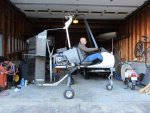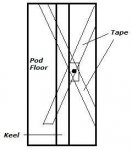A quarter-wave antenna is theoretically 36 ohms since it's half of a dipole antenna which is 72 ohms. The dipole antenna needs no ground plane but can you imagine a 46" antenna sticking up somewhere on the outside of our gyro's.
On a dipole, the shield of the coax feeds one half of the antenna while the center wire of the coax feeds the other half. In a quarter-wave antenna installation, the coax's center wire feeds the insulated antenna element while the shield "feeds" the ground or is grounded to the metal structure. The metal material around the antenna becomes the other half of the antenna system. Even though this is not a di-pole in the purest sence, electrically it is still a di-pole, being that the aircraft structure becomes the ground plane.
The formula for figuring a half wavelength is: 492 / freq(in MHz) x 12 to give the length in inches. So to figure a quarter wavelength, the formula would be: 246 / freq(MHz) x 12. However, those figures are generally for frequencies below 30 MHz or so (shortwave bands). It's been found that as your frequency increases above 30 MHz, the ends of the antenna begin to affect the real world length and calculations need to be adjusted dowm about 5%. So we use a slightly different formula: 236/freq (MHz) for antenna lengths at our operating frequencies for real world applications.
Example:
find a quarter-wave antenna length for a 121 MHz operating frequency.
(236/121x12) 236 / 121 = 1.95' x 12" = 23.4" for the rod.
The ground plane radials should be 5% more or about 24.6". If they are longer, it's not a problem.
If, for example, you use 118.0 MHz for the lower end of your "operating range of channels" and 126 MHz for the upper end, you'll find that the center frequency will be 122 MHz. Therefore if you cut your antenna for 122 MHz it will be the most efficient at that frequency with a slight loss at 118 and 126. This loss will only be measurable with an SWR tester. The lengths for those two frequencies will be approximately 23.8" for 118 MHz and approximately 22.3" for 126 MHz. So we have a difference of 1.5" over that 8 MHz channel spread. This is why we say the length is nothing to get really concerned about. In our 121 MHz example, a half inch either way from the 23.4" calculation will work just fine. Of course, there comes a point where the SWR is a problem, I personally trimmed my radiator (antenna element) to be resonant at 122.8 combined with an attached ground plane in base of my pod. This gives me the best SWR of 1.1to 1; the farther off frequency you go the greater the SWR. But, at the extremes of our range, I still only see about 2 to 1. Please note, the higher the SWR the less efficient the transmitting system becomes and will cause internal damage to your radio.
The ground plane, or counterpoise as it's actually called, is at the base or feedpoint (where the coax is connected) to the antenna. Ideally, the ground plane would be a disc with a radius of 5% or more than the active (vertical) element or, in our example of 23", about 24-1/4". However, on our gyros, it is not practical. We can use 4 wires or rods in place of the disc with excellent results but again, depending on the aircraft/application, it may not be practical. In my particular application on my Dominator gyro. I utilize a piece of metal sheeting and basically lined the bottom of the pod, passing across between the keel and pod.


